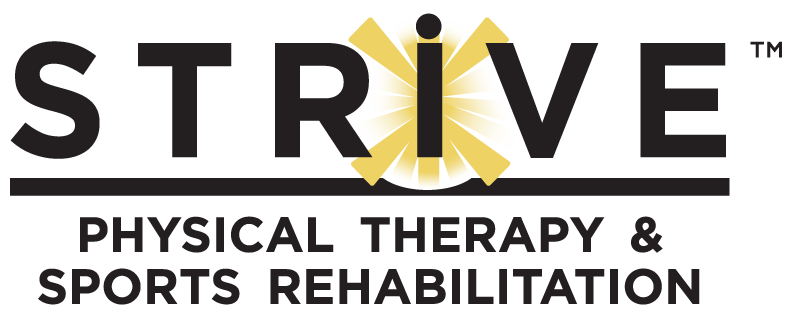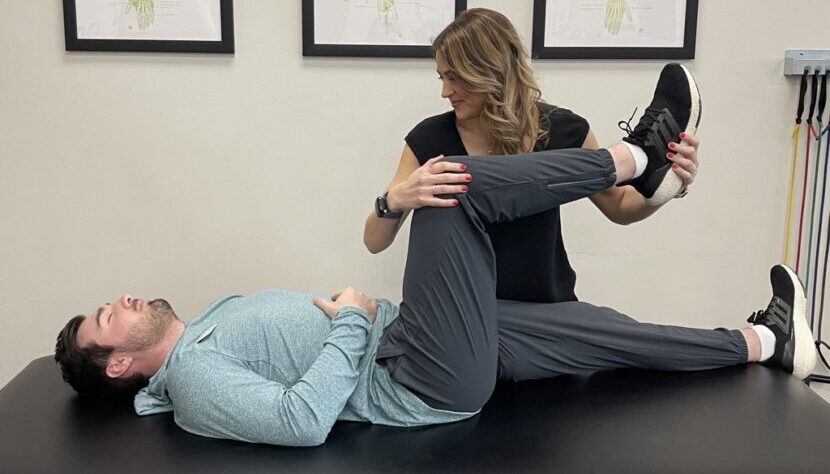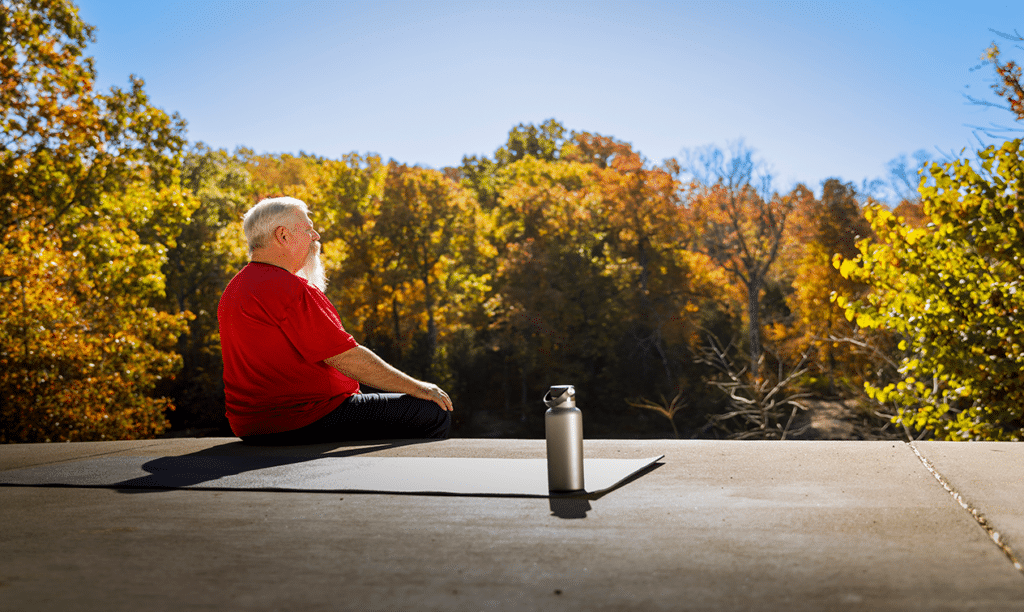Strive Physical Therapy has been operating since 2005. Strive is proudly owned by physical therapists. Our objective is to improve the quality of life of every client and community group we have the opportunity to serve. With very few exceptions, NJ law allows patients to receive physical therapy treatment from a licensed physical therapist without a referral or prescription.
Okay – But what is PT? And what should you expect? – Don’t worry! We’re here to ask all your questions.
Amanda Steward, Physical Therapist in our Moorestown location was able to answer some of the frequently asked questions about PT with us. Amanda, affectionately referred to as ACE, not only has her doctorate in Physical Therapy but has recently passed the certification exam to be certified as an orthopedic specialist. She is extremely passionate about Physical Therapy and her daily work. She truly enjoys getting to improve the lives of others through daily commitment and compassion for each individual she comes in contact with.
Although physical therapy can be offered in a variety of settings, we’re going to focus on commonly asked questions in regards to what to expect at your PT experience here at Strive.
What is physical therapy?
As per the State Board of Physical Therapy Examiners in summary, “Physical therapy” and “physical therapy practice” means the identification of physical impairment, movement-related functional limitation, or balance disorder that occurs as a result of injury or congenital or acquired disability, or other physical dysfunction.
- Identification of your impairment is through examination, evaluation and diagnosis of the physical impairment or movement-related functional limitation and the establishment of a prognosis (timeline of outcomes)
- Treatment of the physical impairment or movement-related functional limitation, which shall include, but is not limited to: the alleviation of pain, physical impairment and movement-related functional limitation by therapeutic intervention.
- Therapeutic intervention can include: manual therapy techniques and massage, electro-therapeutic modalities, wound care, the use of physical agents, mechanical modalities, hydrotherapy, therapeutic exercises with or without assistive devices, neurodevelopmental procedures, joint mobilization, movement-related functional training in self-care, providing assistance in community and work integration or reintegration, providing training in techniques for the prevention of injury, impairment, movement-related functional limitation, or dysfunction, providing consultative, educational/other advisory services, and collaboration with other health care providers in connection with patient care.
What happens in a therapy session?
When you arrive, we will bring you back to start your session. Your session may begin with a modality such as heat, an active warm up on/off a machine, or with manual treatment techniques performed by your physical therapist.You can ask questions at any time regarding your symptoms, pain management, pathology or if you need to review performance of your home exercise program.
Your interventions/flowsheet prescribed by your physical therapist will be performed throughout the session. These are specific exercises geared towards improving your progress towards your specific goals which may include: strength, flexibility, range of motion, endurance, balance, coordination, or body mechanics
Physical therapy aides are under direct supervision of a physical therapist. You will often see them assisting in cleaning and preparing equipment for the next patient which assists tremendously with clinic cleanliness, organization, and patient flow. An aide may guide you to the right area of equipment for these exercises, but your physical therapist will instruct you in proper performance.
Your session may or may not end with heat, ice, or modalities including: traction or electrical stimulation per recommendations from your doctor or treating physical therapist based on the pathology you are being seen for
Why do I have to do these exercises? Some of them make me sore…
Muscle soreness is a key indication that you are challenging your body to make changes and progressing towards functional recovery.If you feel that the soreness is more than normal, review your exercise performance and prescription with your physical therapist to make sure that everything is correct.
Why does meeting my goals with physical therapy take longer than I had thought?
Some common factors that can affect your timeline of progress can include:
- The duration of time you have had your symptoms in relation to the time you were initially evaluated for physical therapy (if you have had your symptoms longer than 3 months this can be considered chronic pain and possibly take you longer to see results). No matter what duration you have had your symptoms; physical therapy has been proven effective in improving the quality of life of individuals dealing with physical ailments
- You may have current or past medical history which includes co-morbidities that can affect your progress
- You may not be consistent in your nutrition, hydration, and sleep quality which can also hinder the rate of your progress. These factors though are highly in your control, it is just up to you to make the necessary changes to accelerate your progress
Do I really have to do home exercises?
Adhering to your home exercise program consistently as prescribed by your physical therapist is essential to success in meeting your functional goals
Most physical therapy prescriptions will maximize at 3x per week. In this case there are 4 days per week that you are not being seen in the clinic by your physical therapist. Performing your prescribed home exercises allows you to stay consistent in your exercise performance and prevent any regression in the progress you’ve made with skilled care; helping to get you better, faster!
What’s the difference between physical therapy and occupational therapy (OT)?
Occupational therapists like physical therapists are available in a variety of clinical settings. Both professions aim to improve the quality of life of the patient through therapeutic intervention and education in health and prevention of injury.
Occupational therapists strongly emphasize using daily activities (occupations) as their interventional approach with hands on cueing. Physical therapists will examine your movement mechanics and musculoskeletal deficits affecting your functional performance and address those with specific interventions. Physical therapists can also use occupational and daily intervention activities with patients who are seen under worker’s compensation insurance or who wish to improve their performance with activities of daily living with their PT monitoring their quality of movement.
Is PT painful?
Pain is a universal human experience but it is experienced and interpreted very differently by every single individual. Patients will often quote “no pain no gain” and “PT stands for physical torture right?” I feel that this creates a negative outlook for future patients hoping to try physical therapy.
Pain is often a reason patients opt for physical therapy treatment. In this case and especially in post operative cases patients will present initially reporting pain limiting their quality of life, and report goals to get rid of pain as part of their functional outcome performance.
Physical therapists often educate patients regarding their pain through making them knowledgeable in regards to pain science and the system of the brain and body connection. Patients then are able to realize that their pain experience can be reduced simply through education and positive approaches to pain management such as exercise!
It is important for the patient to communicate consistently the level of pain and discomfort they are having with performing an intervention, or having a manual technique performed on them in order for the physical therapist to make the appropriate adjustments for the patient’s experience.
What if the pain or problem returns?
It is very common that aches and pains will return especially with repetitive activities, repetitive stress and heavy loads, or even from inactivity.Symptoms can often return when a patient fails to maintain consistent performance of their home exercises, experiences increased stress levels, and/or difficulty maintaining healthy routines
Physical therapy helps to equip the patient with the knowledge and confidence that they need to address the return of their symptoms with a more active approach.If the patient does not feel they can manage the return of symptoms on their own, they are able to return to physical therapy for assistance and treatment.
How many visits will I need?
The amount of visits for physical therapy is very highly dependent on the diagnosis you are being seen for. The amount of visits may be prescribed and recommended through a prescription from your doctor if you have been referred by them to participate in physical therapy.
If you seek physical therapy care independently through direct access provided by your insurance, then you and your physical therapist will determine your plan of care. Ultimately, you and your physical therapist will discuss the frequency and duration of your care to maximize your functional outcomes and goals set for physical therapy.
Do you need a prescription for physical therapy?
Depending on the type of medical insurance you have, you may require a prescription from your doctor in order to be evaluated and treated with physical therapy care.
If your insurance allows direct access, you are able to be evaluated by a physical therapist prior to seeing your physician. This is a great opportunity for the patient to be seen as soon as the day of injury to get started with treatment and prevent the patient from waiting to be seen. This can prevent the patient from developing poor movement mechanics and habits that would hinder future progress and increase pain with activities of daily living.
Can my Physical Therapist provide me with a diagnosis?
Physical therapists are highly trained in evaluation and examination of the human body. You are able to receive a physical therapy diagnosis at the end of your evaluation based on the physical therapist’s findings the day of your initial evaluation.
- For example, if you are being seen for right knee pain affecting your walking you may receive diagnosis of ICD 10 codes including: M25561 pain in right knee, R2689 other abnormalities of gait and mobility
If you are looking for a more specific diagnosis, research has presented physical therapists with statistical references resulting in clinical prediction rules which assist with making more accurate diagnoses and predictions for ailments such as osteoarthritis, shoulder impingement, and rotator cuff injury.
Amanda Steward, PT, DPT, OCS… Read Amanda’s bio here .



